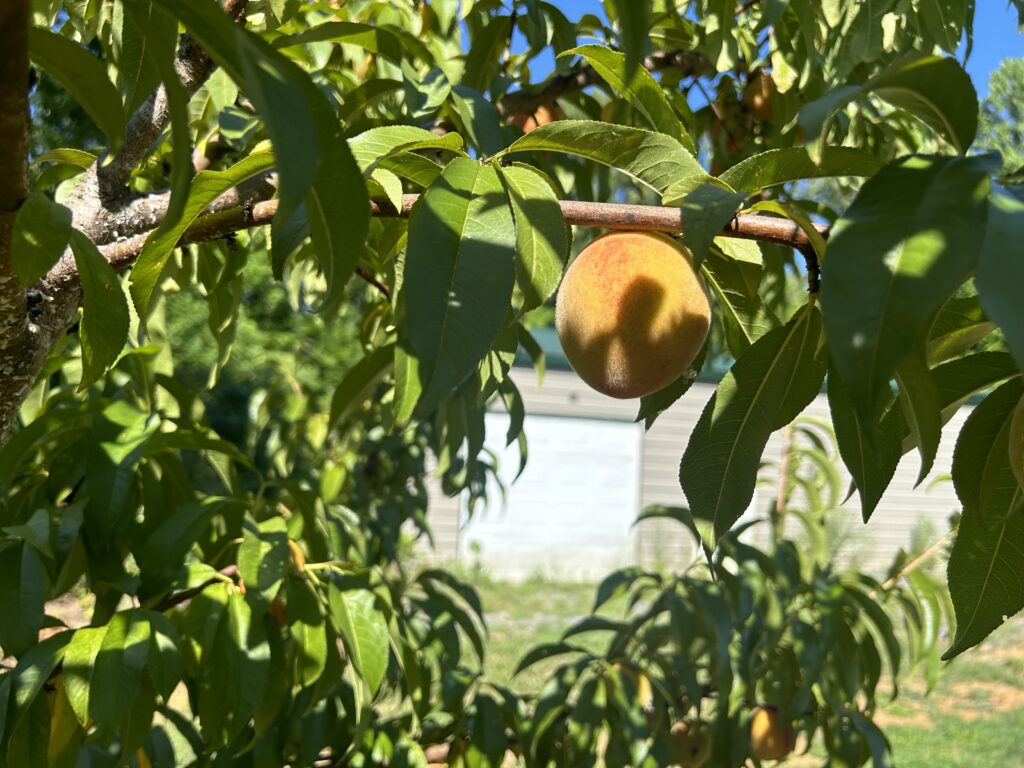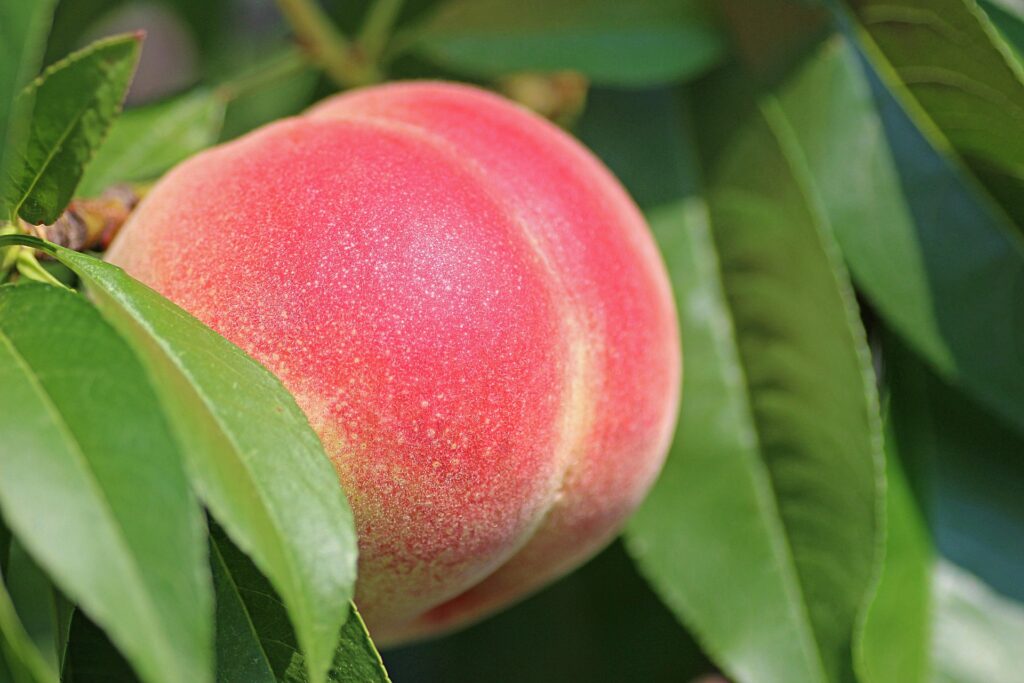Peach trees are one of my favorite fruit trees, not only are they a beautiful tree to grow but these trees will provide you with a ton of fruit. There is nothing quite as good as a peach grown to ripeness on the tree, not like the one you find in the grocery store.
Best kind of peaches to grow.
Although like most plants and fruits a lot depends on your zone but here are some of my favorite peaches. I have 7 different types of peach trees on my farm. I am in zone 7.

Zone 7 is a great climate for growing many varieties of peach trees, as it has a moderate winter chill that most peaches need for dormancy, along with a long enough growing season. When choosing the best peach trees for USDA Zone 7, it’s important to consider:
- Chill hour requirements (Zone 7 typically gets 700–1,000 chill hours)
- Disease resistance
- Harvest time (early, mid, or late season)
- Freestone vs. clingstone (freestone are easier to process)
Top Peach Varieties for Zone 7
1. Redhaven
- Chill Hours: ~950
- Ripens: Midseason
- Type: Freestone
- Notes: Very reliable, cold hardy, excellent flavor and texture
2. Elberta
- Chill Hours: ~800
- Ripens: Mid to late season
- Type: Freestone
- Notes: Classic southern peach, vigorous tree, good for fresh eating and canning
3. Contender
- Chill Hours: ~1,050
- Ripens: Mid to late season
- Type: Freestone
- Notes: Extremely cold hardy, great flavor, disease-resistant
4. Reliance
- Chill Hours: ~1,000
- Ripens: Early to midseason
- Type: Freestone
- Notes: Cold hardy, productive, slightly softer fruit
5. Harvester
- Chill Hours: ~750
- Ripens: Early to midseason
- Type: Freestone
- Notes: High yield, good for fresh eating and preserves
6. Georgia Belle
- Chill Hours: ~850
- Ripens: Midseason
- Type: Freestone
- Notes: Heirloom white peach, aromatic, juicy
7. Belle of Georgia
- Chill Hours: ~850
- Ripens: Mid to late season
- Type: Freestone
- Notes: White flesh, large fruit, excellent for pies and preserves
Different Types of Peaches
Peaches come in a wide variety of types based on several key characteristics. Here’s a breakdown of the main types of peaches, categorized by pit type, flesh color, use, and shape:
1. By Pit Type
This is the most common way peaches are classified:
Freestone
- Flesh separates easily from the pit
- Great for fresh eating, baking, and canning
- Usually larger and less juicy than clingstone
- Examples: Redhaven, Elberta, Contender
Clingstone
- Flesh clings tightly to the pit
- Sweeter and juicier; more tender
- Often used for commercial canning or processing
- Examples: Springcrest, June Gold
Semi-freestone (Semi-cling)
- A hybrid type: easier to pit than clingstone, but not fully freestone
- Good for both fresh use and light processing
- Examples: Suncrest, Harvester
2. By Flesh Color
Yellow-Fleshed
- Most common in the U.S.
- Bold, sweet-tart flavor
- Often more acidic than white varieties
- Examples: Redhaven, Elberta, Harvester
White-Fleshed
- Sweeter, lower acidity, floral or honey-like flavor
- Popular in Asia and increasingly in the U.S.
- More delicate texture
- Examples: Belle of Georgia, White Lady
Red-Fleshed (Blood Peaches)
- Rare, often heirloom or specialty varieties
- Deep red or purple streaks in flesh
- Intense flavor, sometimes with berry notes
- Example: Indian Free Peach
3. By Use
Fresh Eating
- Juicy, flavorful, usually freestone or semi-freestone
- Examples: Redhaven, Contender, Belle of Georgia
Canning or Baking
- Firm, freestone, with well-balanced flavor
- Examples: Elberta, Loring, Veteran
Processing (Commercial)
- Often clingstone, consistent in size and sweetness
- Examples: Babygold series, Springcrest
4. By Shape
Classic Round Peaches
- The typical shape most people know
Donut (Saturn) Peaches
- Flat, saucer-shaped
- Usually very sweet, white-fleshed, and low-acid
- Popular for fresh snacking
- Example: Saturn Peach
Best Fresh Eating Peaches
Great! For fresh eating, you’ll want peach varieties that are sweet, juicy, and have excellent texture right off the tree. Here are the top peach trees for fresh eating in Zone 7:
Top Picks for Fresh Eating
1. Redhaven
- Taste: Sweet, rich flavor
- Texture: Firm, smooth flesh
- Why it’s great: Often considered the standard for fresh eating—low fuzz, juicy, and dependable.
2. Contender
- Taste: Very sweet and flavorful
- Texture: Firm but juicy
- Why it’s great: Stays firm when ripe, doesn’t brown quickly, ideal for eating fresh off the tree.
3. Harvester
- Taste: Balanced sweetness and tang
- Texture: Smooth, juicy flesh
- Why it’s great: Ripens a bit earlier; great texture and flavor for snacking.
4. Belle of Georgia (white peach)
- Taste: Aromatic, very sweet with a floral note
- Texture: Soft, very juicy
- Why it’s great: A fan-favorite among white peach lovers for its unique sweetness.
5. July Prince
- Taste: Exceptionally sweet and flavorful
- Texture: Large, meaty fruit with great bite
- Why it’s great: Delicious fresh, and ripens in midsummer (great for staggering harvests).
Canning Peaches
Perfect—when it comes to canning, you’re looking for peaches that:
- Hold their shape when processed
- Have a balanced sugar-acid flavor
- Are freestone (much easier to pit and peel)
- Have firm, dense flesh (so they don’t go mushy)
Best Peach Varieties for Canning in Zone 7
1. Elberta
- Type: Freestone
- Ripens: Mid to late season
- Why it’s great: Classic canning peach—large, firm, sweet-tart flavor that holds up beautifully in jars.
2. Redhaven
- Type: Freestone
- Ripens: Midseason
- Why it’s great: Also excellent for fresh eating, but it holds texture well enough for canning. Balanced flavor and easy to peel.
3. Harvester
- Type: Freestone
- Ripens: Early to midseason
- Why it’s great: Good texture and flavor balance, slightly smaller fruit but productive and reliable.
4. Veteran
- Type: Freestone
- Ripens: Late season
- Why it’s great: Less commonly grown now but prized by canners—firm, juicy, and very flavorful.
5. Loring
- Type: Freestone
- Ripens: Midseason
- Why it’s great: Large fruit, great texture, good balance of sweetness and acidity—makes beautiful canned slices.

My personal favorite
You really cant beat an Elberta peach, The Elberta peach is known for its exceptional balance of sweetness and acidity, making it one of the most flavorful and versatile peaches available. Its large, golden-yellow fruit with a vibrant red blush offers firm, juicy flesh that holds up beautifully whether eaten fresh, baked into pies, or preserved through canning. It is very reliable, good disease resistance, and heavy yields. Their classic peach flavor and excellent texture have made them a go-to favorite for generations of home gardeners and orchardists alike.

No responses yet